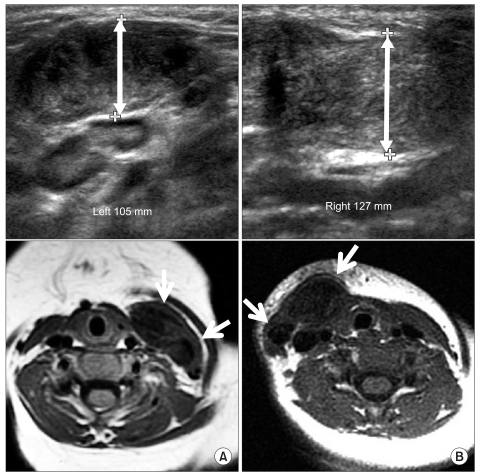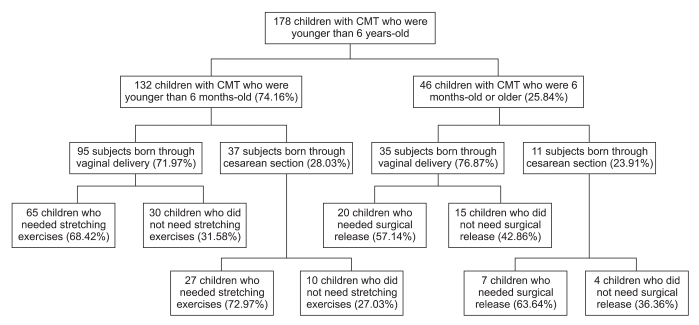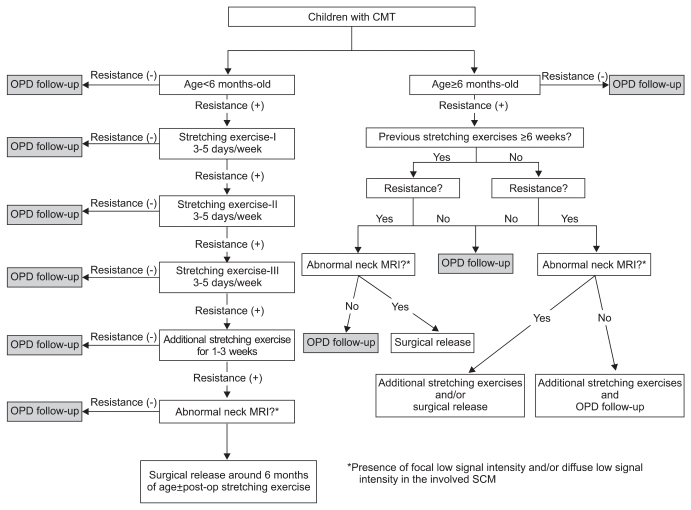Comparison of Clinical Severity of Congenital Muscular Torticollis Based on the Method of Child Birth
- Affiliations
-
- 1Department of Physical Medicine and Rehabilitation, Ajou University School of Medicine, Suwon 442-749, Korea. syyim@ajou.ac.kr
- 2Department of Plastic and Reconstructive Surgery, Ajou University School of Medicine, Suwon 442-749, Korea.
- KMID: 2267225
- DOI: http://doi.org/10.5535/arm.2011.35.5.641
Abstract
OBJECTIVE
To compare the clinical severity of congenital muscular torticollis (CMT) based on the method of child birth. METHOD: Children diagnosed with CMT and who were < 6-years-of-age at the time of their first visit at the Center for Torticollis, Ajou Medical Center, were included in this study. The medical records were retrospectively reviewed with reference to the method of child birth and the clinical severity of CMT. The clinical severity of CMT was determined either by whether stretching exercises were needed for the children <6-month-of-age or whether surgical release was required for the children > or =6-months-of-age at the time of the first visit.
RESULTS
One hundred seventy eight subjects with CMT were enrolled. There was no significant difference in the rate of surgical release according to the method of child birth. For 132 patients <6-month-of-age there was also no significant difference in the rate of stretching exercises.
CONCLUSION
There was no significant difference in the clinical severity of CMT based on the method of child birth. This finding suggests that prenatal factors alone could be a cause of CMT and that the clinical severity of CMT in children delivered by Cesarean section is not different when compared with the severity of CMT in children born through vaginal delivery.
MeSH Terms
Figure
Cited by 3 articles
-
Factors That Affect the Rehabilitation Duration in Patients With Congenital Muscular Torticollis
Ah Young Jung, Eun Young Kang, Sung Hoon Lee, Doo Hyeon Nam, Ji Hwan Cheon, Hyo Jung Kim
Ann Rehabil Med. 2015;39(1):18-24. doi: 10.5535/arm.2015.39.1.18.Quantitative Analysis of Magnetic Resonance Imaging of the Neck and Its Usefulness in Management of Congenital Muscular Torticollis
Jong Woo Kim, Seung Hyun Kim, Shin-Young Yim
Ann Rehabil Med. 2015;39(2):294-302. doi: 10.5535/arm.2015.39.2.294.Effectiveness of Surgical Release in Patients With Neglected Congenital Muscular Torticollis According to Age at the Time of Surgery
Kyung-Jay Min, Ah-Reum Ahn, Eun-Ji Park, Shin-Young Yim
Ann Rehabil Med. 2016;40(1):34-42. doi: 10.5535/arm.2016.40.1.34.
Reference
-
1. Chen MM, Chang HC, Hsieh CF, Yen MF, Chen TH. Predictive model for congenital muscular torticollis: analysis of 1021 infants with sonography. Arch Phys Med Rehabil. 2005; 86:2199–2203. PMID: 16271571.
Article2. Hsu TC, Wang CL, Wong MK, Hsu KH, Tang FT, Chen HT. Correlation of clinical and ultrasonographic features in congenital muscular torticollis. Arch Phys Med Rehabil. 1999; 80:637–641. PMID: 10378488.
Article3. Yim SY, Lee IY, Cho KH, Kim JK, Lee IJ, Park MC. The laryngeal cough reflex in congenital muscular torticollis: is it a new finding? Am J Phys Med Rehabil. 2010; 89:147–152. PMID: 19730356.4. Binder H, Eng GD, Gaiser JF, Koch B. Congenital muscular torticollis: results of conservative management with long-term follow-up in 85 cases. Arch Phys Med Rehabil. 1987; 68:222–225. PMID: 3566514.5. Canale ST, Griffin DW, Hubbard CN. Congenital muscular torticollis. A long-term follow-up. J Bone Joint Surg Am. 1982; 64:810–816. PMID: 7085709.
Article6. Cho KH, Kim JY, Lee IY, Yim SY. Congenital muscular torticollis in siblings: a case report and literature review. J Korean Acad Rehabil Med. 2009; 33:731–734.7. Engin C, Yavuz SS, Sahin FI. Congenital muscular torticollis: is heredity a possible factor in a family with five torticollis patients in three generations. Plast Reconstr Surg. 1997; 99:1147–1150. PMID: 9091917.
Article8. Lidge RT, Bechtol RC, Lambert CN. Congenital muscular torticollis; etiology and pathology. J Bone Joint Surg Am. 1957; 39-A:1165–1182. PMID: 13475414.9. Suzuki S, Yamamuro T, Fujita A. The aetiological relationship between congenital torticollis and obstetrical paralysis. Int Orthop. 1984; 8:175–181. PMID: 6530313.
Article10. Cheng JC, Tang SP, Chen TM, Wong MW, Wong EM. The clinical presentation and outcome of treatment of congenital muscular torticollis in infants--study of 1,086 cases. J Pediatr Surg. 2000; 35:1091–1096. PMID: 10917303.11. Hummer CD, MacEwen GD. The coexistence of torticollis and congenital dysplasia of the hip. J Bone Joint Surg Am. 1972; 54:1255–1256. PMID: 4652057.
Article12. Davids JR, Wenger DR, Mubarak SJ. Congenital muscular torticollis: sequela of intrauterine or perinatal compartment syndrome. J Pediatr Orthop. 1993; 13:141–147. PMID: 8459000.13. Do TT. Congenital muscular torticollis: current concepts and review of treatment. Curr Opin Pediatr. 2006; 18:26–29. PMID: 16470158.14. Yim SY, Lee IY, Park MC, Kim JH. Differential diagnosis and management of abnormal posture of the head and neck. J Korean Med Assoc. 2009; 52:705–718.
Article
- Full Text Links
- Actions
-
Cited
- CITED
-
- Close
- Share
- Similar articles
-
- Familial Congenital Muscular Torticollis: A Case Report
- Two Cases of Sternomastoid Tumor
- Unipolar Release of the Sternocleidomastoideus in Congenital Muscular Torticollis in Children
- Congenital Torticollis with Bilateral Sternocleidomastoid Muscle Contracture
- Biterminal Sternocleidomastoid Tenotomy for the Treatment of Congenital Muscular Torticollis in Children




